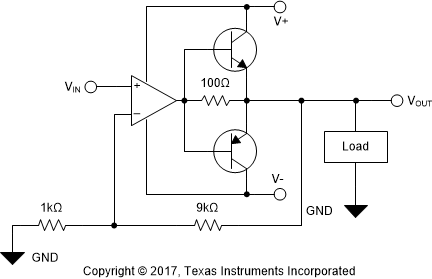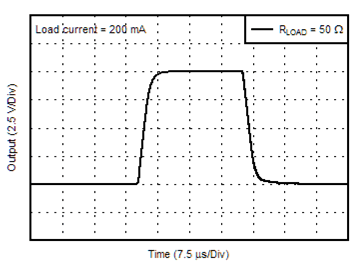SBOS826D December 2017 – October 2019 OPA207
PRODUCTION DATA.
- 1 Features
- 2 Applications
- 3 Description
- 4 Revision History
- 5 Pin Configuration and Functions
- 6 Specifications
- 7 Detailed Description
- 8 Application and Implementation
- 9 Power Supply Recommendations
- 10Layout
- 11Device and Documentation Support
- 12Mechanical, Packaging, and Orderable Information
Package Options
Mechanical Data (Package|Pins)
Thermal pad, mechanical data (Package|Pins)
Orderable Information
8.2.3 Precision Buffer With Increased Output Current
The OPA207 can be configured as illustrated in Figure 50 to drive low impedance loads. In Figure 50, the OPA207 is configured in a gain of +10 V/V, and the output current is boosted by the NPN (2N2904) and PNP (2N2906) bipolar transistors. For low output voltages the OPA207 supplies the load current directly through the 100-Ω resistor. The bipolar transistors begin to supply current when the voltage drop across the 100-Ω resistor exceeds approximately 500 mV. Figure 50 illustrates the results for a 50-Ω load resistor driven with a 10-V step at the output. This results in a 200-mA current supplied by the circuit.
 Figure 50. Precision Buffer (G = 10 V/V) With High Output Drive Capability
Figure 50. Precision Buffer (G = 10 V/V) With High Output Drive Capability  Figure 51. 50-Ω Load Driven With a 10-V Step
Figure 51. 50-Ω Load Driven With a 10-V Step